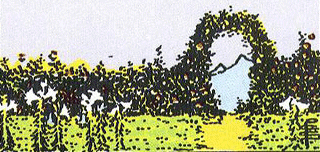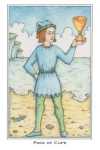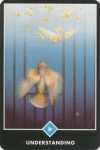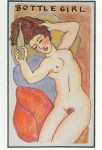
Postmodern Decks Beginning With N-R
This page is part of a larger tarot site. Click here to start at the top.

Native American Tarot. Magda Weck Gonzalez and illustrated by J. A. Gonzalez. 1988 US Games Systems. - Native American theme deck. I bought this deck shortly after it came out. Based on what little I know now about a few of the peoples whose lands I've motorcycled through, I have come to feel somewhat ashamed to own this deck. They meant well.


- A Picture Is Worth 1000 Words - Native American
- David Roell's Review
- Rev. Gina M. Pace's Review at Wicce's Tarot Collection
- Joan Bunning
- Aeclectic Tarot - 2 1/2 stars
- Symitar's Review
- Anonymous Review at Learning the Tarot
- Tarot Deevah's Review
Magda Weck Gonzalez and illustrated by J. A. Gonzalez. Star Spider Speaks: The Teachings of the Native American Tarot. 1992: US Games Systems. ISBN: 0880793694
Nigel Jackson Tarot. Nigel Jackson. 2000 Llewellyn Publications. Rereleased in 2004 as Medieval Enchantment: The Nigel Jackson Tarot - I acquired this deck for its lovely pastel illustration style. Wands=Air, Swords=Fire. The images hark back to the early renaissance handpainted decks and blend elements from those older decks with scenic elements from RWS in many cases. Nigel Jackson's expertise is in the older strains of Renaissance Magick, rather than the syncretic system of the Golden Dawn. He is featured on Christopher Warnock's Renaissance Astrology site. Hauntingly beautiful ethereal and delicate art. One of my all-time favorite decks.


- A Picture Is Worth 1000 Words - Rider Waite Art Twist Decks
- A Picture Is Worth 1000 Words - Elvish and Fae
- A Picture Is Worth 1000 Words - SCA Period
- Nigel Jackson Talisman Images
- David Roell's Review
- Aeclectic Tarot images and review - 4 1/2 stars
- Randall's Review at the Cauldron
- Rev. Gina M. Pace's Review at Wicce's Tarot Collection
- Joan Bunning
- Tarot Deevah's Review
- Card Samples at the Mystic Eye
Tarot of Northern Shadows. Sylvia Gainsford and Howard Rodway. 1997 AGMuller. - This deck combines Norse mythology (Rods), the Welsh Mabinogion (Cups), British Celtic and Continental legend (Swords) and Irish mythology (Discs).


- Sylvia P. Gainsford web site
- David Roell's Review
- Aeclectic Tarot - 3 1/2 stars
- Tarot Deevah's Review
- Rev. Gina M. Pace's Review at Wicce's Tarot Collection
- Joan Bunning
- Card Samples at the Mystic Eye
Rodway, Howard. Tarot of Northern Shadows. 1998: AGM AGMuller ISBN: 3-905219-29-8
Old English. Maggie Kneen. 1997 US Games Systems. - Inspired by the Luttrell Psalter as well as old Tarots. Realize that the Luttrell Psalter had no connection to Tarot at the time of its creation, since Tarot was invented later, and in a completely different geographic area. The connection with the psalter, therefore, is providing an artistic style for the artist to emulate. While there are little scenes on the pips in addition to the arrangement of suit emblems, their relationship to traditional meanings, whether RWS (which are those described in the LWB, which is a particularly useless example of a generally useless document) or Etteilla-based, is very inconsistent. The swords suit scenes are pretty well related, but the batons simply show various agricultural scenes. The cups show different musicians and tumblers who might appear at a feast. The coins are a blend between vaguely related agricultural scenes and elements of RWS images. This is a deck I would take to Pennsic or an SCA event. It's a little early for a typical Renn Faire. At any rate, I wouldn't recommend it as a reading deck for someone uncomfortable with Marseilles-style pips, due to the inconsistency of the scenes.



-
Also recommended
- A Picture Is Worth 1000 Words - SCA Period
- The Luttrell Psalter 1345
- The British Library - Turning the Pages (digitized with shockwave - turn the pages and see several pages of the book)
- View the Deck at WebPress Tarot Reader
- David Roell's Review
- Aeclectic Tarot - 3 1/2 stars
- Rev. Gina M. Pace's Review at Wicce's Tarot Collection
- Joan Bunning
- Images of entire deck at Tarot.com
Camille, Michael. Mirror in Parchment: The Luttrell Psalter and the Making of Medieval England
Tarot of the Old Path. Sylvia Gainsford and Howard Rodway. 1990 AGMuller. -


- Sylvia P. Gainsford web site
- Tom Tadfor Little Meet My Tarot Decks
- David Roell's Review
- Aeclectic Tarot - 4 1/2 stars
- Rev. Gina M. Pace's Review at Wicce's Tarot Collection
- Joan Bunning
Rodway, Howard. Tarot of the Old Path. 1990: Urania Verlags ISBN: 3-908647-17-7
The Osho Zen Tarot: The Transcendental Game of Zen. Ma Deva Padma (Susan Morgan). 1994 St Martin's Press. - The art is excellent and evocative. The cards provide a great deal of food for thought, as they reinterpret traditional meanings through the filter of Osho's spirituality. Osho is the (late) guru who was also known as Bhagwan Shree Rajneesh. The Zen here is not necessarily true Zen, at least not in the Japanese branch of Buddhism sense, as it has been stripped of all relationship to its Japanese origins. But this is the most Zen deck available that I know of, and I don't feel (other than the Master card) that it has the same failings as the human it is named after. It is an excellent exercise in Tarot knowledge to relate the Osho meanings back to traditional meanings. It is doable to some extent or another, but not always obvious.



- A Picture Is Worth 1000 Words - Hippie
- Osho web site
- Interview with Ma Deva Padma
- Osho and Tarot by Jeannette Roth
- David Roell's Review
- Aeclectic Tarot - 5 stars
- Rev. Gina M. Pace's Review at Wicce's Tarot Collection
- Joan Bunning
- Tarot Deevah's Review
- Bonnie Cehovet's Review
- Anonymous Review at Learning the Tarot
- N. Levine's review at Tarot Insights
- Entire Deck at ScorpioSite
Osho International Foundation. Osho Zen Tarot: The Transcendental Game of Zen. 1994: St Martins Press. ISBN 0-312-11733-7 (came with deck)
Osho International Foundation. Tarot in the Spirit of Zen: The Game of Life 2003: St. Martins Press. ISBN 0312317670
PoMo Tarot. Brian Williams. 1994 Harper Collins. - If Morgan's Tarot captures the energy of the 1970s, this deck captures the 1990s. The suits are Bottles, Guns, TVs and Dollar Bills, and the cards are basically modified sketches of famous works of art. The book goes into the artwork the card was based on, and if you go back and find these pieces (in books or by web search) you can acquire an introductory art history education with this deck. Of course it's out of print now, so rather difficult to find.

- A Picture Is Worth 1000 Words - Cold War and Beyond
- The artist's web site
- Tom Tadfor Little Meet My Tarot Decks
- Aeclectic Tarot - 4 stars
- Rev. Gina M. Pace's Review at Wicce's Tarot Collection
- Anonymous Review at Learning the Tarot
Williams, Brian. The PoMo Tarot: A Postmodern Deck for Navigating the Next Millenium. 1994: HarperSanFrancisco. ISBN: 0-06-250965-9
The Renaissance Tarot. Brian Williams. 1987 US Games Systems. - This is probably the most elegant and understated deck in my collection. This is a Wands=Air Swords=Fire deck based on Greco-Roman mythology and Renaissance Italian cities. The book is extremely informative on Tarot History, and is of far higher utility than most books written to accompany decks.



- A Picture Is Worth 1000 Words - SCA Period
- The artist's web site
- Tom Tadfor Little Meet My Tarot Decks
- David Roell's Review
- Aeclectic Tarot - 5 stars
- Rev. Gina M. Pace's Review at Wicce's Tarot Collection
- Joan Bunning
- Card Samples at the Mystic Eye
Williams, Brian. Renaissance Tarot Book : A Guide to the Renaissance Tarot. 1997: US Games Systems. ISBN: 088079545X
Robin Wood Tarot. Robin Wood. 1991 Llewellyn Publications. - This deck has a positive attitude. A few cards (like the Wheel of Fortune) really leave me cold, but most are very nice. This deck is very popular among Neo-Pagans. The artwork is lively, and the mood is friendly. The symbolism usually follows Rider-Waite, except that references to Christianity are often replaced with with references to Neopaganism, and the images are made more naturalistic. The court cards mainly emphasize the element of the suit, adding cues to time of day. Many people find that the court cards from this deck really help them internalize Fire, Water, Air and Earth. However, the courts do not really show the element and subelement [counterchange] relationship or nor do they highlight the astrological attributions. Her book is both detailed and readable, and is better informed about Tarot history than I'm used to seeing in a companion book.



- A Picture Is Worth 1000 Words - Rider Waite Close Redrawings
- The author's web site
- Interview with Robin Wood
- David Roell's Review
- Aeclectic Tarot - 4 stars
- Linda Gail Walters' Review
- Rev. Gina M. Pace's Review at Wicce's Tarot Collection
- Joan Bunning
- Tarot Deevah's Review
- Tracy Hite's Review at LexFA
- N. Levine's review at Tarot Insights
- Tainted Tarot's Review
Wood, Robin. Robin Wood Tarot: The Book 1998: Livingtree Books; ISBN: 0965298418
Available at her web site.
used to illustrate Louis, Anthony. Tarot Plain and Simple 1996: Llewellyn; ISBN: 1567184006
The Rock Art Tarot. Jerry Roelen. 1996 US Games Systems. - Based on petrographs and petroglyphs from desert cultures around the world; especially of the American Southwest. Like Whimsical, meanings are generally riffs off of the Rider Waite image, but since you have to know something about rock art to know what the figures are; it's not very apparent. If petroglyphs and petrographs don't speak to you, or you are turned off by the neon-bright marker coloring in, you might not like this deck.



- A Picture Is Worth 1000 Words - Native American
- Ikonian Eye web site (about rock art)
- Review by Lady Lorelei, CTR
- Aeclectic Tarot - 2 stars
- Rev. Gina M. Pace's Review at Wicce's Tarot Collection
- Joan Bunning
- Tarot Deevah's Review
Roelen, Jerry. Rock Art Tarot. 1996: US Games Systems. ISBN 0-88079-194-2
Also recommended - a non-mystical guidebook of symbol meanings:
Patterson, Alex. A Field Guide to Rock Art Symbols of the Greater Southwest
The Rock and Roll Tarot. Chris Paradis. 1997, 2000, 2002 Self Published - Artists and performers from the first fifty years of Rock and Roll. Suits are Voice (Wands), Muse (Cups), Guitars (Swords) and Albums (Discs).

- Rock and Roll Tarot Homepage
- Magical Omaha Review
- All Tarot Review
- Aeclectic Tarot - 3 stars
- Rev. Gina M. Pace's Review at Wicce's Tarot Collection
- Card Samples at the Mystic Eye
Rohrig Tarot. Carl-W. Rohrig. 1995 Bluestar Communications. Printed in Belgium. - High style airbrush art that reminds me of something that would be seen in a magazine. There are generally chunks of spiral-bound notebook pages illustrated on the cards, and written on these are keywords (usually from Thoth) in English and German. The art, while very professional, has six cards with disembodied female breasts collaged in, and feels vaguely female-exploitative to me in general. I don't get that feeling from Cosmic Tribe, which is much more nude. Perhaps because in Cosmic Tribe, the genitalia is still attached to the person. I do find many of the cards very evocative, especially the way the Minors were handled, but in the end, the deck has a soft porn feel I find disturbing.



- A Picture Is Worth 1000 Words - Cold War and Beyond
- Bluestar's website
- Card Samples at the Mystic Eye
- Aeclectic Tarot - 4 stars
- Rev. Gina M. Pace's Review at Wicce's Tarot Collection
- Joan Bunning
Carl-W. Röhrig and Francesca Marzano-Fritz. The Röhrig-Tarot Book. 1997: Bluestar Communications. ISBN 1-885394-18-7

This page is part of a larger tarot site. Click here to start at the top.


